�
Systems & Control: Foundations & Applications
Series Editor
Tamer Ba~ar, University of Illinois at Urbana-Champaign
Editorial Board
Karl Johan Astrom, Lund Institute of Technology, Lund, Sweden
Han-Fu Chen, Academia Sinica, Beijing
William Helton, University of California, San Diego
Alberto Isidori, University of Rome (Italy) and
Washington University, St. Louis
Petar V. Kokotovic, University of California, Santa Barbara
Alexander Kurzhanski, Russian Academy of Sciences, Moscow
and University of California, Berkeley
H. Vincent Poor, Princeton University
Mete Soner, Ko~ University, Istanbul
�
Daniel Liberzon
Switching in
Systems and Control
Springer Science+Business Media, LLC
�
Daniel Liberzon
Coordinated Science Laboratory
University of lllinois at Urbana-Champaign
Urbana, IL 61801
U.S.A.
library of Congress Cataloging-in-Publication Data
Liberzon, Daniel, 1973
Switching in systems and control I Daniel Liberzon.
p. cm. - (Systems and control)
Includes bibliographical references and index.
ISBN 978-1-4612-6574-0
DOI 10.10071978-1-4612-0017-8
ISBN 978-1-4612-0017-8 (eBook)
1. Switching theory. 2. Automatic control. I. Title. II. Series.
TK7868.S9L53 2003
621.3815'372-dc21
2003050211
CIP
AMS Subject Classifications: Primary: 93B12, 93D05, 93D09, 93D15, 93D20; Secondary: 34D20,
34030, 34H05
Printed on acid-free paper
© 2003 Springer Science+Business Media New York
Originally published by Birkhauser Boston in 2003
Softcover reprint of the hardcover 1st edition 2003
All rights reserved. This work may not be translated or copied in whole or in part without the written
permission of the publisher (Springer Science+Business Media, LLC), except for brief excerpts in
connection with reviews or scholarly analysis. Use in connection with any form of information storage
and retrieval, electronic adaptation, computer software, or by similar or dissimilar methodology now
known or hereafter developed is forbidden.
The use in this pUblication of trade names, trademarks, service marks and similar terms, even if they
are not identified as such, is not to be taken as an expression of opinion as to whether or not they are
subject to proprietary rights.
ISBN978-1-4612-6574-0 SPIN 10888361
Typeset by the author.
987654321
�
Contents
Preface
I
Introduction
1 Basic Concepts
l.1 Classes of hybrid and switched systems.
1.1.1 State-dependent switching . . . .
l.l.2 Time-dependent switching . . . .
l.l.3 Autonomous and controlled switching
1.2 Solutions of switched systems . . . . .
1.2.1 Ordinary differential equation!:>
1.2.2 Zeno behavior ... .
1.2.3 Sliding modes ... .
1.2.4 Hy!:>teresis switching
II Stability of Switched Systems
2 Stability under Arbitrary Switching
2.1 Uniform stability and common Lyapunov functions
2.1.1 Uniform !:>tahility concepts ...
2.1.2 Common Lyapunov functions .
2.1.3 A converse Lyapunov theorem
2.1.4 Switched linear systems . . . .
ix
1
3
3
5
6
8
9
9
10
12
14
17
21
21
21
22
24
26
�
VI
Contents
2.1.5 A counterexample . . . . . .
2.2 Commutation relations and stability
2.2.1 Commuting systems . . . . .
2.2.2 Nilpotent and solvable Lie algebras.
2.2.3 More general Lie algebras . . . . . .
2.2.4 Discussion of Lie-algebraic stability criteria
2.3 Systems with special structure
2.3.1 Triangular systems ... .
2.3.2 Feedback systems . . . . .
2.3.3 Two-dimensional systems
3 Stability under Constrained Switching
3.1 Multiple Lyapunov functions
.
3.2 Stability under slow switching.
3.2.1 Dwell time . . . . . . .
3.2.2 Average dwell time .. .
3.3 Stability under state-dependent switching
3.4 Stabilization by state-dependent switching .
3.4.1 Stable convex combinations ..
3.4.2 Unstable COnvex combinations
III Switching Control
4 Systems Not Stabilizable by Continuous Feedback
4.1 Obstructions to continuous stabilization
4.1.1 State-space obstacles .
4.1.2 Brockett's condition . . . . . . .
4.2 Nonholonomic systems . . . . . . . . . .
4.2.1 The unicycle and the nonholonomic integrator
4.3 Stabilizing an inverted pendulum . . . . . . . .
5 Systems with Sensor or Actuator Constraints
5.1 The bang-bang principle of time-optimal control
5.2 Hybrid output feedback . . . . . . . . . . .
5.3 Hybrid control of systems with quantization
5.3.1 Quantizers . . . . . . . . .
5.3.2 Static state quantization ..
5.3.3 Dynamic state quantization
5.3.4
Input quantization . . . . .
5.3.5 Output quantization ... .
5.3.6 Active probing for information
6 Systems with Large Modeling Uncertainty
Introductory remarks . . . . . . . . . . . . .
6.1
28
30
30
34
37
41
42
43
45
51
53
53
56
56
58
61
65
65
68
73
77
77
77
79
81
83
89
93
93
96
100
100
103
108
116
121
124
129
129
�
Contents
vii
6.2 First pass: basic architecture . . . . .
6.3 An example: linear supervisory control
6.4 Second pass: design objectives. . . . .
6.5 Third pass: achieving the design objectives
. . .
6.5.1 Multi-estimators
6.5.2 Candidate controllers . . . .
6.5.3 Switching logics. . . . . . . .
6.6 Linear supervisory control revisited.
6.6.1 Finite parametric uncertainty
6.6.2
Infinite parametric uncertainty
6.7 Nonlinear supervisory control . . . . .
6.8 An example: a nonholonomic system with uncertainty
IV Supplementary Material
A Stability
A.1 Stability definitions . . . . . . . . .
A.2 Function classes K, K oc , and K£ .
A.3 Lyapunov's direct (second) method
A.4 LaSalle's invariance principle ...
A.5 Lyapunov's indirect (first) method
A.6 Input-to-state stability . . . . . . .
B Lie Algebras
B.l Lie algebras and their representations
B.2 Example: sl(2, IR) and gl(2, IR) . . . . .
B.3 Nilpotent and solvable Lie algebras ..
B.4 Semisimple and compact Lie algebras.
B.5 Subalgebras isomorphic to 81(2, IR)
B.6 Generators for gl(n, IR) . . . . . . .
Notes and References
Bibliography
Notation
Index
131
134
137
139
139
142
145
154
156
159
160
163
167
169
169
170
171
173
174
175
179
179
180
181
181
182
183
185
203
229
231
�
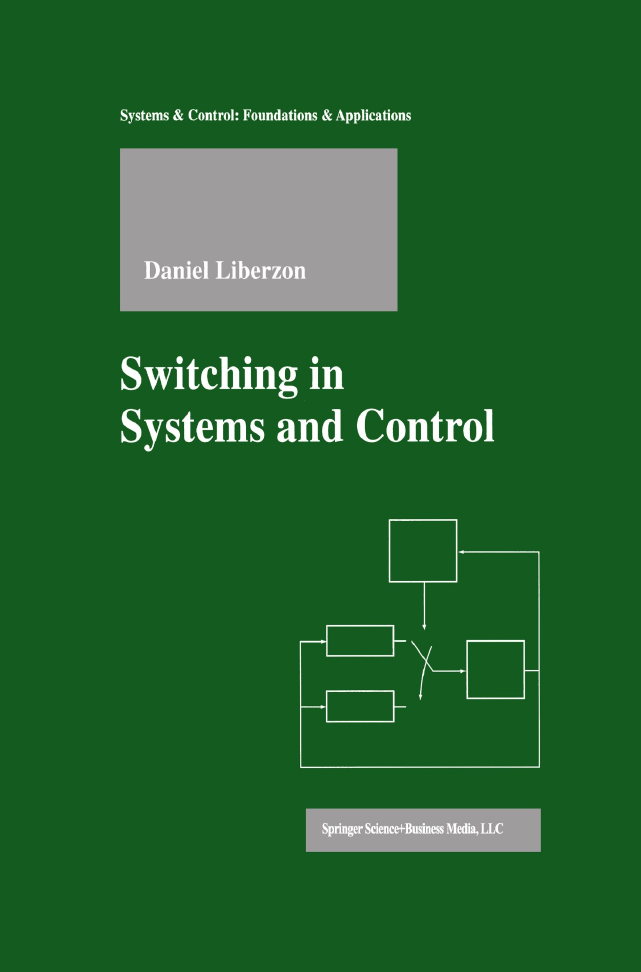

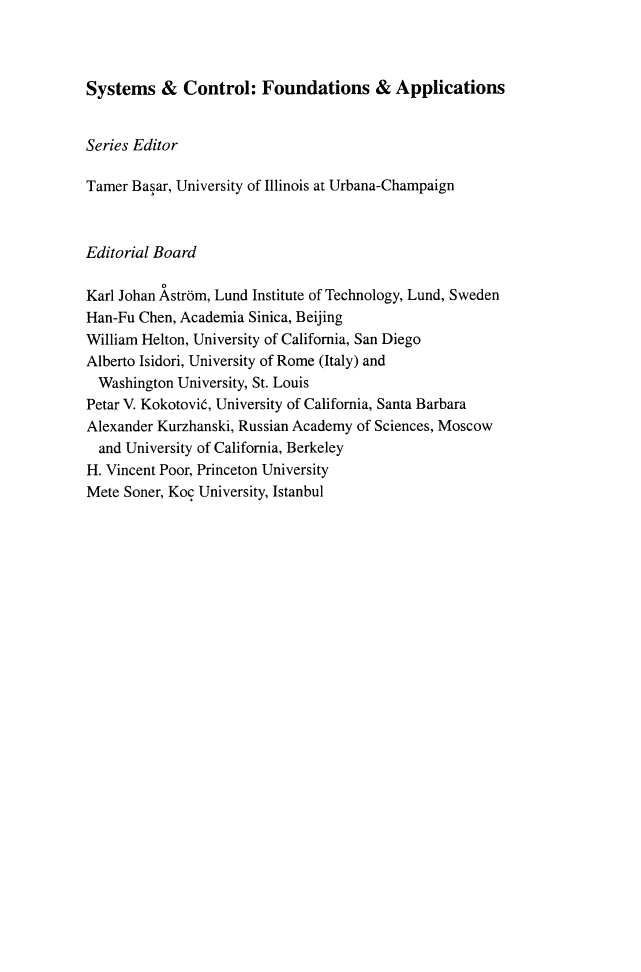

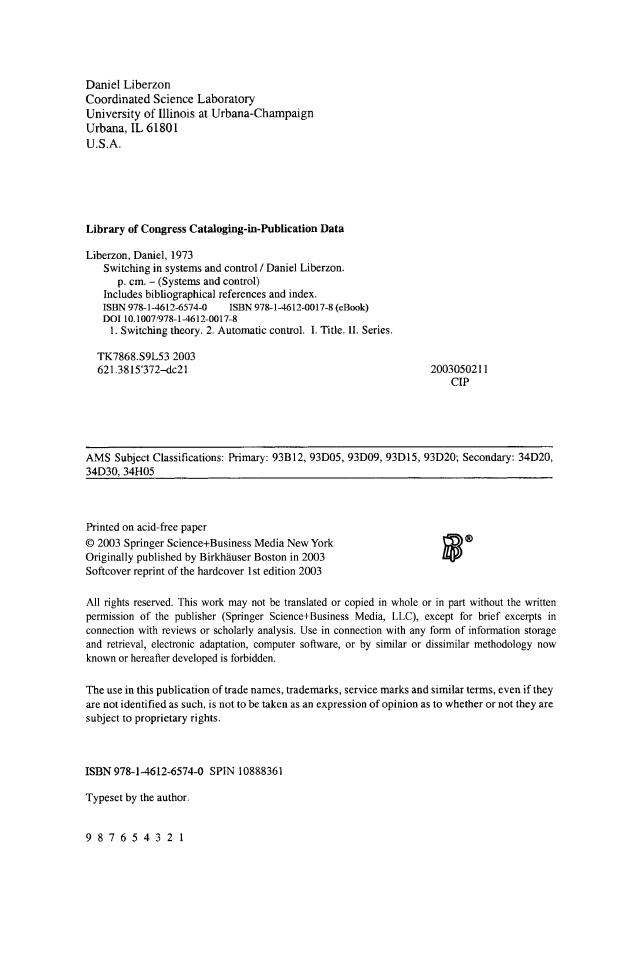

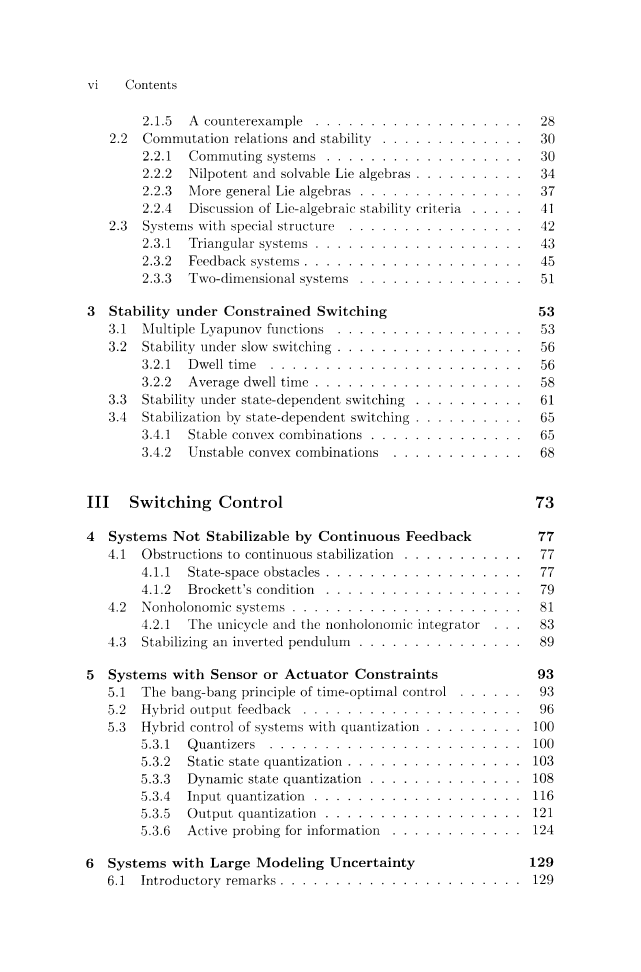
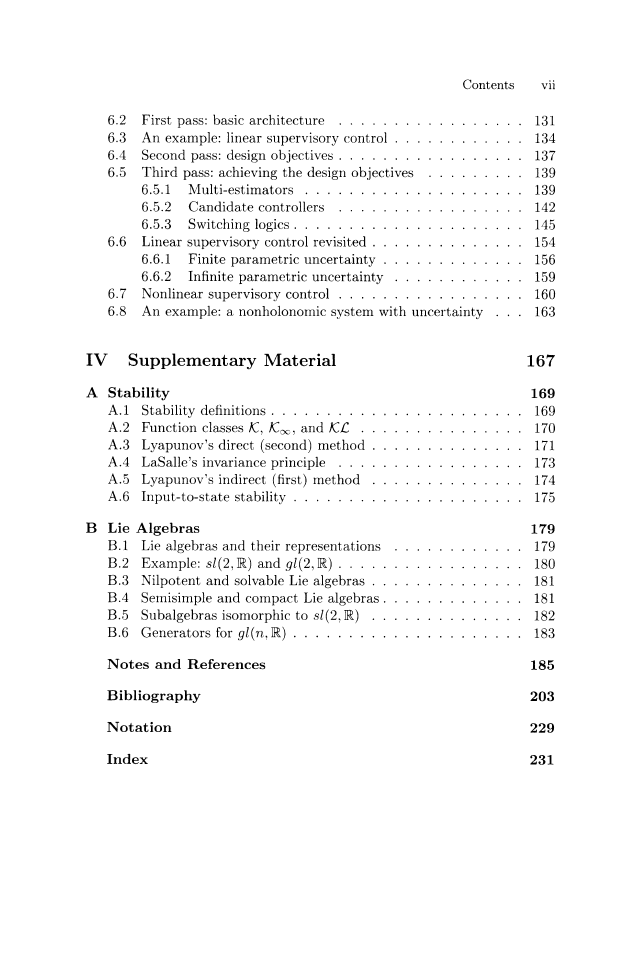








 2023年江西萍乡中考道德与法治真题及答案.doc
2023年江西萍乡中考道德与法治真题及答案.doc 2012年重庆南川中考生物真题及答案.doc
2012年重庆南川中考生物真题及答案.doc 2013年江西师范大学地理学综合及文艺理论基础考研真题.doc
2013年江西师范大学地理学综合及文艺理论基础考研真题.doc 2020年四川甘孜小升初语文真题及答案I卷.doc
2020年四川甘孜小升初语文真题及答案I卷.doc 2020年注册岩土工程师专业基础考试真题及答案.doc
2020年注册岩土工程师专业基础考试真题及答案.doc 2023-2024学年福建省厦门市九年级上学期数学月考试题及答案.doc
2023-2024学年福建省厦门市九年级上学期数学月考试题及答案.doc 2021-2022学年辽宁省沈阳市大东区九年级上学期语文期末试题及答案.doc
2021-2022学年辽宁省沈阳市大东区九年级上学期语文期末试题及答案.doc 2022-2023学年北京东城区初三第一学期物理期末试卷及答案.doc
2022-2023学年北京东城区初三第一学期物理期末试卷及答案.doc 2018上半年江西教师资格初中地理学科知识与教学能力真题及答案.doc
2018上半年江西教师资格初中地理学科知识与教学能力真题及答案.doc 2012年河北国家公务员申论考试真题及答案-省级.doc
2012年河北国家公务员申论考试真题及答案-省级.doc 2020-2021学年江苏省扬州市江都区邵樊片九年级上学期数学第一次质量检测试题及答案.doc
2020-2021学年江苏省扬州市江都区邵樊片九年级上学期数学第一次质量检测试题及答案.doc 2022下半年黑龙江教师资格证中学综合素质真题及答案.doc
2022下半年黑龙江教师资格证中学综合素质真题及答案.doc